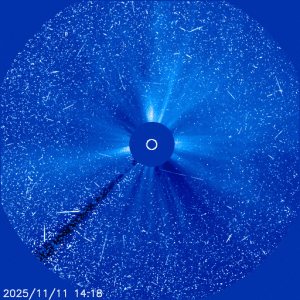Solar ‘Hailstorm’ Bombards Satellites in Dramatic Space Event
A powerful solar storm is creating a “hailstorm in space,” peppering Earth-orbiting satellites with high-energy particles and disrupting space-based observations. NASA’s SOHO spacecraft captured stunning footage showing what appears as a cosmic blizzard hitting camera sensors.
Key Takeaways
- Solar storm bombarding satellites with energetic particles
- SOHO spacecraft captured dramatic “space hailstorm” footage
- Massive solar flare from sunspot 4274 triggered the event
- Some particles powerful enough to reach ground level
- Solar activity expected to increase toward 2025-26 peak
What a Solar Proton Storm Looks Like
In NASA-released animations, the SOHO spacecraft’s C3 coronagraph shows flickering white specks covering the usually clear view. Each speck represents a charged particle slamming into the satellite’s camera sensor.
“This is what a solar proton storm looks like from space,” explained solar physicists monitoring the event. “The Sun is essentially peppering our instruments with energetic particles, and the result is this blizzard-like interference.”
The phenomenon resembles television snow but is actually subatomic particles hitting the camera’s CCD detector.
Solar Fury Unleashed
The radiation storm originated from a massive solar flare erupting from sunspot 4274. The flare expelled highly energetic protons toward Earth, with some particles so powerful they penetrate deep into the atmosphere and reach ground level.
These high-speed protons and electrons travel millions of kilometers, reaching Earth’s vicinity within minutes to hours. When they collide with satellite sensors, they cause temporary “fogging” or pixel noise, degrading image quality and scientific data.
Satellite Impacts and Future Risks
While space agencies emphasize that most satellites are built to withstand such events, prolonged or intense storms can damage sensitive electronics, interfere with communications, and affect navigation systems.
Solar radiation storms are expected to become more frequent as the Sun approaches the peak of its 11-year activity cycle, known as solar maximum, in 2025-26. Scientists are closely tracking these outbursts to better predict their impact on technology and space missions.





